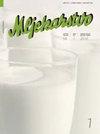Analysis of 18 elements in Alpine goat milk in the first third of lactation
IF 1.1
4区 农林科学
Q3 AGRICULTURE, DAIRY & ANIMAL SCIENCE
引用次数: 0
Abstract
The research objective was to examine the influence of the first third of the lactation stage on 18 mineral elements in Alpine goat milk. The research was carried out on 20 goats of the French-Alpine breed, which were on average 5 years old and in the fourth lactation. The goats were monitored on the 30th and the 90th day of lactation. Their milk was analysed for chemical composition by the infrared spectroscopy. By means of inductively coupled plasma (ICP), a total of 18 minerals were analysed (Ca, P, K, Na, K, Mg, Fe, Zn, Cu, Se, Mn, Mo, Co, Cr, Ni, Cd, Pb, As and Hg). The period of milk sampling in the first third of lactation significantly influenced the changes in concentrations of Na, Se, Mo, Cr, Ni and As. Significantly higher concentrations of Na and As were determined in milk sampled on the 90th day, while lower concentrations of Se, Mo, Cr and Ni were determined in milk sampled on the 30th day of the first third of lactation. Analysis of the correlation coefficients between the investigated trace elements and the selected toxic elements in Alpine goat milk showed a significantly positive correlation between Ca:Mg, Ca:P, Ca:Co, Ca:Ni, Ca:Mo; Mg:P, Fe:As, Pb:Cd and P:Ni. In the first third of lactation, Alpine goat milk contained a very low concentration of heavy metals. The described changes indicate that Alpine goat milk is rich in essential elements, while the concentration of toxic elements is very low in the first third of lactation.分析阿尔卑斯山山羊奶中 18 种元素在哺乳期前三分之一的含量
研究目的是考察泌乳期前三分之一阶段对阿尔卑斯山羊奶中 18 种矿物质元素的影响。研究对象是 20 只平均年龄为 5 岁、处于第四个泌乳期的法国阿尔卑斯品种山羊。在泌乳期的第 30 天和第 90 天对这些山羊进行了监测。用红外光谱分析了羊奶的化学成分。通过电感耦合等离子体 (ICP),总共分析了 18 种矿物质(钙、磷、钾、钠、钾、镁、铁、锌、铜、硒、锰、钼、钴、铬、镍、镉、铅、砷和汞)。泌乳期前三分之一的牛奶采样期对 Na、Se、Mo、Cr、Ni 和 As 的浓度变化有显著影响。在第 90 天采样的牛奶中,Na 和 As 的浓度明显较高,而在泌乳期前三分之一的第 30 天采样的牛奶中,Se、Mo、Cr 和 Ni 的浓度较低。对阿尔卑斯山羊奶中调查的微量元素与所选有毒元素之间的相关系数进行分析后发现,Ca:Mg、Ca:P、Ca:Co、Ca:Ni、Ca:Mo;Mg:P、Fe:As、Pb:Cd 和 P:Ni 之间存在显著的正相关。在泌乳期的前三分之一,阿尔卑斯山羊奶中的重金属浓度很低。上述变化表明,阿尔卑斯山羊奶富含必需元素,而在泌乳期的前三分之一,有毒元素的浓度非常低。
本文章由计算机程序翻译,如有差异,请以英文原文为准。
求助全文
约1分钟内获得全文
求助全文
来源期刊

Mljekarstvo
Agricultural and Biological Sciences-Animal Science and Zoology
CiteScore
1.90
自引率
41.70%
发文量
18
审稿时长
12 weeks
期刊介绍:
Mljekarstvo is an open access, peer-reviewed international quarterly scientific journal. The first issue was published in 1951, by the Croatian Dairy Operators'' Association (today: Croatian Dairy Union, publisher). In a paper at a Union conference held 28 October 1951 in Zagreb it was said: "Our desire is that this magazine does not meet the fate of its predecessors, but that it continues to reflect the creative efforts and to provide guidelines for the producers as well as all other operators employed in the dairy industry."
It is our pleasure today to say that wishes of the enthusiasts who attended the conference have come true, and the magazine Mljekarstvo during the last six decades was a reflection of the creative efforts of numerous dairy scientists and experts, and through its texts it served as a guideline in improving production and processing of milk and dairy products. Mljekarstvo has been following all the achievements of the dairy profession in Croatia, and it also gives the short surveys of world achievements. The result of the research of local and foreign scientists and experts always find their place in the magazine Mljekarstvo. It has been edited by our outstanding dairy experts employed at colleges, research institutions and dairy companies.
 求助内容:
求助内容: 应助结果提醒方式:
应助结果提醒方式:


